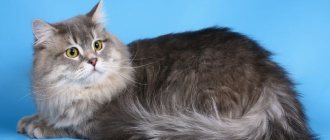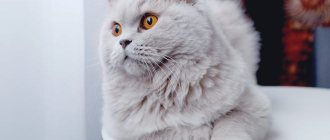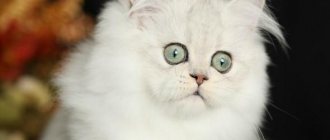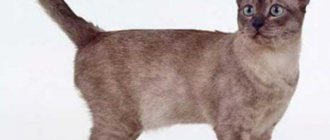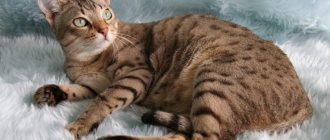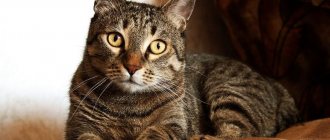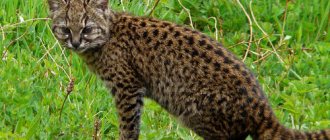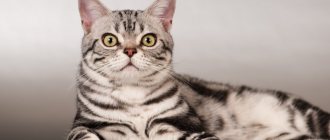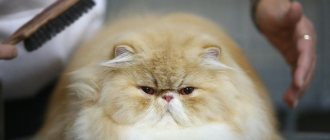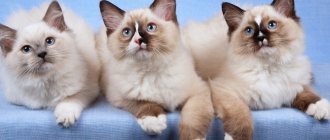Breed characteristics
The Highland Straight is an officially recognized breed. According to approved standards, Scottish Straight Longhair cats have the following characteristics.
The head is round in shape with thick fur and plump cheeks. Neat chin. Short, wide nose. Pretty face.
Representatives of the Scottish breed have large eyes. Round. The outer corners look raised up. The look always seems slightly surprised. The color of the iris is in harmony with the color of the coat. Heterochromia occurs in some individuals.
Small ears. The tips are rounded. Wider at the base. Erect. The inside is covered with thick fur.
Highland straights are considered miniature representatives of the cat family. The body is round, with well-developed muscles. The average weight of adult individuals is five to six kilograms. Males are much larger than females.
Straights' legs are short. Paws are rounded. Dense tufts of wool are planted between the toes. This feature makes the gait of animals absolutely silent.
Fluffy tail of medium length.
The standards allow any types of colors and patterns of Highland Straight coat.
History of the breed
The Scottish mountainous regions, called the Highlands, are the historical cradle of the Highland Straight breed. It was there that the distant wild ancestors of modern domestic Scottish cats lived. Hence the name of these four-legged cats.
The Scottish Straight-eared Longhair received official recognition only in the seventies of the twentieth century.
Breeding work was carried out on crossing British cats with Persians and Himalayan breeds. Breeders worked to develop a unique breed with good health and a variety of coat colors.
At first, long-haired individuals were considered a cull. They didn't pay enough attention. However, over time, breeders were still able to appreciate the unique external characteristics of the new breed of cats.
To this day, there are not many nurseries that breed Highland Straights. But those who have become the happy owners of these four-legged animals never tire of singing their praises. So the breed still has every chance to one day conquer this world.
Interesting facts in the life of animals
Initially, Highlands were considered defective animals and did not want to be recognized as a separate breed. This would have continued earlier if several scientists had not decided, as an experiment, to bring the Straits together with the Persians and the British. The results were so impressive that they decided to give the Highlands a chance.
The Highland, along with other Scots, is considered one of the safest breeds. It is believed that they do not have the aggression gene, although in reality it is worth thanking the breeders for such a character. Only friendly pets were allowed to breed, so the quality was established.
The Highland is a miniature breed. The average body weight of representatives is 4 kg. There are babies weighing 2-2.5 kg. Highlands can look massive only due to their developed muscles and lush coat.
Character and psychology
Affectionate and flexible - these are perhaps the key character traits of the Scottish Straight cat. Why are they loved so immensely?
At a young age, Highland Straights are, of course, not such “couch” cats. Lovers of frolic. Such “mass people are entertainers.” Always busy either thinking about or implementing a wide variety of cat tricks.
However, already at the age of one year, straight cats mature. They calm down their childish ardor and become sort of imposing, fluffy aristocrats.
Highland Straight breeders unanimously recognize the high intelligence of their four-legged friends. Representatives of the breed quickly get used to the home routine and accept the boundaries of what is permitted. They are easy to train, enthusiastically learning the simplest commands.
The Straits are distinguished by their independence. They, of course, adore their owner with all their cat souls. But they also need to be alone from time to time.
Scottish cats are monogamous. They treat all family members kindly, but only one person becomes the love of their life. But even these mustachioed striped ones don’t stay in his arms for long. This is the nature of the breed.
Highland straight character
Highland Straights are intelligent and inquisitive cats. They are very friendly towards their family. As a rule, these cats do not hide around the house and are not shy - on the contrary, they always follow their household members from room to room like a tail.
This breed is called four on the floor kitties by breeders and show judges (translated from English as “a cat with all four paws standing on the ground”). That is, Highlands will always be next to you, but at the same time they will “stand firmly on the floor” - they do not like being picked up too much, depriving them of reliable support. They also do not like idleness - they are always busy with something.
Highland Straights are smart and curious cats
The intelligence and curiosity of the Highland allows them to learn things like opening doors to look inside, turning lights on and off to understand how this strange process works. Some Highlands can be trained to fetch and fetch.
Many pets love to drink running water, which is why they learn to open the taps. A few more funny features of the breed - they often drink and eat with the help of their paws, take the pose of hunting dogs when they hear unusual sounds, and look around carefully. But the cutest habit of all cats of the Scottish group is to take the “Buddha pose”, that is, sit down in human style and rest like that for hours.
This is a rather imposing and quiet breed. They are affectionate and kind, and get along well with other animals if they came into the house before the Highland Straight. If you are planning to bring another animal into a house where there is a Highland, then you need to introduce them carefully so that the cat does not get jealous. However, for those whom the Highland has accepted into his “pack”, he will become the most affectionate and devoted comrade. This active and at the same time patient breed is perfect for children of any age and large families. The main thing is not to pick up the cat too often, so that it doesn’t get scared and accidentally hurt itself and the baby.
Video: features of the long-haired straight-eared breed
How to choose a kitten
Choosing a Highland Straight kitten begins with finding a suitable cattery. At an early age, the characteristic features of the breed are hardly noticeable, which is why kids can easily be confused with young representatives of other breeds or even yard kittens.
The reputation of the nursery must be impeccable. Attention is paid to the site, reviews of previous customers, documentation, and the interior environment.
Kittens should be taken to a new family no earlier than three to four months of age. An earlier move has a negative impact on both the psychological and physical health of the furry baby.
By about twelve weeks, the baby becomes independent enough from his mother, the cat, to go to a new family. Another plus is that by this time the first vaccinations will have already been done.
Particularly scrupulous breeders try to create conditions in nurseries that are as close as possible to home ones. Animals are allowed to move freely around the area and communicate with each other. Such an atmosphere greatly facilitates the further socialization of four-legged animals.
When meeting someone, pay close attention to his appearance. Clean ears, clear eyes without discharge. Soft tummy. Shiny flowing coat with thick undercoat. A healthy baby is playful, curious, and happy to make contact.
Since the key pedigree characteristics of Highland Straights appear only at eight months, we can only rely on the conscience of the nursery owners.
Breeding Highland Straights
Highland straights are much easier to breed than folds, still due to the absence of the Fd mutant gene.
But before buying a cat, you need to take felinological courses and register the cattery with an organization or breed club . Only after this can you buy cats for breeding. Breed or show class cats are suitable. Highland straights ripen at 8–9 months. Both cats must participate in shows from the age of 10 months to receive breeding grades. Without them they will not be allowed to breed.
It is allowed to cross Highland Straights with British Shorthair, American Shorthair and British Longhair cats.
The first mating should take place no earlier than 1.5 years of age. Before breeding cats, you need to obtain a certificate from a club or organization. To do this, you need to provide pedigrees and breeding estimates for both cats. Without this, the litter will not be activated, and the kittens will not be considered purebred.
Highland pregnancy lasts from 60 to 65 days. Main signs of pregnancy:
- the cat is sick in the morning (she has toxicosis);
- nipples swell and turn pink;
- Appetite increases and eating preferences may change;
- character changes;
- The cat sleeps more and behaves a little apathetically.
Pregnancy becomes obvious to the naked eye only in the sixth week, but after 3 weeks it can be determined by a professional using ultrasound and palpation.
Pregnancy in Highland Straights lasts at least 2 months.
Kittens are examined by a specially appointed felinologist from a club or organization within 8 weeks after birth. Upon activation, a breeding certificate is issued for the entire litter and a metric for each kitten, which includes the name, breed, color and ancestors of the animal up to the 4th generation. If desired, the metric can be exchanged for a full pedigree.
There are certain rules in naming kittens: each new litter begins with one letter in alphabetical order (the alphabet is usually Latin, but Cyrillic is also possible). That is, the very first litter will have names starting with A, the second - with B, the third - with B or Latin C, and so on. In advance, even when registering the cattery, think about what you will call it: after all, after the kitten’s name the name of the cattery will always be written. It should not be too simple, but also not too pretentious. For example, a cattery with the name “Golden Cats” or “Favorites of the Sun” will look great, but “Cats” or “Man’s Best Friends” - not so much.
Before you start breeding cats, you need to register your cattery
Features of care
In general, caring for representatives of the Highland Straight breed is not much different from caring for other cats. Not burdensome or specific.
Scottish Straights are clean themselves. They only need to be bathed if the pet gets seriously dirty, for example while walking outside.
For water treatments, buy a special cat shampoo for long-haired breeds for your furry friend. After bathing, the mustachioed and striped one is protected from drafts. If the cat is not afraid of a hair dryer, then it can be used to dry its fur.
Straight eyes are prone to watery eyes. They are inspected regularly. At least once a week, treat with a cotton pad or swab dipped in warm water or a special solution. Sold at any veterinary pharmacy. A separate swab is used for each eye.
Check ears once a week. Clean as needed using a soft cloth soaked in a special lotion.
To prevent tartar, your pet's teeth should be brushed. Special cat toothpaste and brush. A children's toothbrush will also work.
The four-legged furry's claws are trimmed as they grow. They are accustomed to the procedure from early childhood. Start with one claw once a week. Gradually the pet gets used to it.
Combing
The Highland Straight belongs to the long-haired representatives of the cat family. Therefore, the animal’s luxurious fur coat requires appropriate attention and care.
The basic set of cosmetic tools includes: a comb with long teeth, a brush with natural bristles, and a special furminator. Straights need to be combed at least once a week. But during the molting period you will have to switch to daily care.
A careless attitude towards your pet's fur will lead to constant problems with fur scattered throughout the apartment.
In addition, the animal develops tangles. Initially they cause physical discomfort. Afterwards, pain occurs. Mats provide an ideal environment for the development of fungal and bacterial infections, which lead to chronic dermatitis.
Experienced breeders advise starting combing with leisurely movements with the comb in the direction of hair growth. Next comes the furminator. They go in the direction of hair growth and against. Complete the procedure with a brush. With its help, the pet is given a massage and “fixed styling.”
Genetics of Scottish cat colors
Scottish fold cats come in different colors; to get kittens of the desired color you need to choose parents with knowledge of genetics:
- In order for a Scottish kitten to turn out red or cream, the coat of both the male and female must be the required color.
- Dominant colors (white, black, smoke, tabby, bicolor, chinchilla) are passed on from parents to offspring, not through generations.
- A Scottish kitten with a dominant color has at least one dominant parent.
- If both dad and mom have a recessive color (cream, blue), then they will not have a single dominant cub.
- A cub with a light undercoat must have a parent with the same undercoat.
- A Scottish chinchilla kitten must have at least one parent with this coat (or tabby). And a tabby baby must have at least one tabby (or chinchilla) parent.
- A chinchilla cat can give birth to smoky offspring, but a smoky cat cannot become the mother of chinchilla kittens.
- A bicolor Scottish kitten must have one of its parents bicolor.
- To produce a color point litter, both mom and dad must be this color.
The owners are responsible for the success of mating and the health of their pets. It is important to choose the right individuals, prepare a comfortable place for them, and minimize stress. Inexperienced owners should consult with breeders and breed club specialists before organizing mating.
Did you like the article?
Nutrition
On the one hand, Highland Straights cannot be classified as picky cats in terms of nutrition. They are omnivores. Moreover, the Scots are real gluttons. And also true admirers of the “sofa” lifestyle. Therefore, breeders should be careful about the quantity and quality of cat food.
The simplest solution is to choose ready-made food. Not lower than premium class. A suitable mixture contains at least forty percent meat. This food is balanced and contains all the microelements and vitamins necessary for your pet’s health.
This is an ideal option for people who do not have extra free time.
For breeders who have the opportunity to independently develop a daily menu, natural nutrition is suitable.
The diet is based on dietary meat. At least seventy percent. Another ten are for offal. Beef, veal, rabbit, turkey, chicken are ideal. Among cereal crops, preference is given to buckwheat and rice.
Kefir is an essential part of the Scottish Longhair's daily diet. Before serving, it is warmed to room temperature. As an alternative, use fermented baked milk or yogurt. Raw vegetables and herbs will add variety to the menu.
When feeding a pet with natural food, the animal is additionally given a vitamin and mineral complex, previously agreed upon with a veterinarian.
It is strictly forbidden to feed the Scottish Highland Straight with milk, fish, sweets, pickles, smoked meats and table food.
A prerequisite for keeping a cat is to provide access to fresh, clean drinking water.
Straights are fed two to four times a day. The serving size is calculated based on the weight, age and lifestyle of the animal.
Health
The absence of the lop ear gene has a beneficial effect on the health of representatives of the Scottish family. Indeed, unlike straights, folds relatively often suffer from problems with the musculoskeletal system.
But even straight-eared cats are predisposed to certain diseases.
Turn of the century. This is due to the relationship with Persian cats. It was from them that the straights inherited a genetic predisposition to this disease. Weakening of the muscles and ligaments of the eyelids leads to deformation of the eyelid. The cornea of the eye begins to rub against the skin and hairs. Why does it get injured over time?
The first manifestations are watery eyes, ingrown hairs, and red eyes. It is important not to miss the moment and contact a specialist in time. Otherwise, there is a high risk of losing the eye.
Hypertrophic cardiomyopathy. Another “gift” from Persian relatives. Deterioration of the heart walls leads to loss of elasticity. Blood circulation improves. The supply of oxygen and nutrients becomes difficult. At first, only an ultrasound will help identify the disease. Late stages cannot be treated. The first symptoms are shortness of breath, fatigue and fainting.
Obesity. With poor nutrition and a sedentary lifestyle, Scottish Straights inevitably develop problems with excess weight and all the accompanying ailments.
With proper care, the average lifespan of Highland Straights is about twenty years.
Why you can’t cross a fold-eared cat with a fold-eared cat
It is precisely in the plane of mating of two fold-eared parents that all the negative genetic consequences in kittens appear. It was proven first experimentally, and later scientific evidence appeared, that all congenital health problems in Scottish cats occur precisely because of this configuration.
Initially, it was believed that the FdFd gene, which is responsible for lop ears, exists in an autosomal dominant form. Later, the nature of his partial dominance was revealed, which changed the entire original concept.
- When mating two fold-eared FdFd, the heirs exhibit all the genetic defects - deformation of the tail and limbs, fusion of the vertebrae and other diseases.
- Crossing a fold-eared FdFd with the same fold-eared dog, but with Fdfd or fdFd, eliminates any health problems and produces offspring with curled ears.
- It is possible to mate Fdfd Fold (fdFd) and Scottish Straight fdfd. In this case, “mixed” children are born.
It turns out that you can breed a straight-eared cat (straight) with a fold-eared cat, and vice versa, there will be no negative impact on the health of the kittens in such a union. But when two Scottish folds are mated, you need to be sure that at least one of the parents has the homozygous Fdfd allele (fdFd).
There is one more. Some kittens have ears that fold first and later rise, although in fact the animals have genes for lop ears. A gradation has been developed according to which the Scots can have 1, 2 or even 3 folds. In the latter case, the auricle is 100% guaranteed to be adjacent to the head and there can no longer be any external changes to it. But the first option is the riskiest. Visually, the animal looks straight-eared, although it has the lop-eared gene.
If crossed with a Scottish Fold, the offspring will most likely get hereditary diseases. So when breeding straight-eared Scottish Straights, you need to have complete confidence in the consistency of the genetics and appearance of the pets.
Vaccinations
Good health is an integral part of a long and happy life for a pet. It is the breeders' job to provide for it. In this matter, vaccination is on the same level as proper nutrition.
Owners of domestic cats often say that their pet does not go outside, which is why it does not need vaccinations. It's a delusion.
Pathogenic microbes and dangerous viruses easily enter the home on people’s clothes and shoes. Pets must be vaccinated. Regardless of their lifestyle!
When the kitten reaches seven to nine weeks, he receives his first vaccination. After two to three weeks, revaccination occurs. It is important to ensure that the procedure does not coincide with the period of the baby’s teeth changing. At this time, the baby’s immunity is especially vulnerable.
Further vaccination occurs on an annual basis. An individual vaccination schedule is drawn up by a veterinarian depending on the characteristics of the animal’s breed and lifestyle. Ten days before vaccination, the cat is dewormed.
In addition, you should visit the veterinary clinic in advance and make sure that your pet is healthy. After all, vaccination is a serious test for the immune system. In a weakened animal, the likelihood of severe complications increases significantly.
Difficulties that may arise during knitting
When mating straights and folds, complications may arise that will prevent you from conceiving offspring. Overcoming these difficulties is possible if you are close to the male and female during the mating process to provide assistance.
- Different sizes. A cat and a female cat may differ in size. This is especially inconvenient if the cat is slightly smaller than the female, since he will not be able to grab the cat by the withers and cover it correctly. In this case, the owners are advised to hold the female at the withers themselves;
- The cat may not give in to the cat, experiencing mistrust and fear. Not all females can overcome these barriers. In such cases, mating cannot occur and, alas, practically nothing can be done;
- Stopping estrus can be caused by stress and illness. That is why both the mental and physical health of the animal must be carefully monitored. An estrus that has stopped due to stress recovers on its own within a few days, but it is still better to avoid such an unpleasant moment;
- Cats very often fall to the side when mating with a cat reaches the active phase. To avoid difficulties during mating, it is best to hold the cat in the desired position.
Where is the best place to look for a suitable mating partner?
Finding a suitable Scottish Straight cat for mating is quite difficult, since this task requires a responsible approach and the ability to distinguish a healthy cat from an unsuitable male. You can find a partner in a special breeders club that specializes in Scottish Folds. Specialists from the club will help you choose the right partner and provide assistance in mating. The cat will be selected taking into account all the characteristics, from the shape of the ear to the weight and correct shape of the skull and skeleton.
It is important to agree on a fee in advance with the owner of the male. One calf per lamb is the most common payment for services provided by a pet. In rare cases, the fee is paid in cash. This is possible in the case when the owner of a male Fold cannot get a Fold kitten, since the litter consists of only Scottish Straight kittens.

